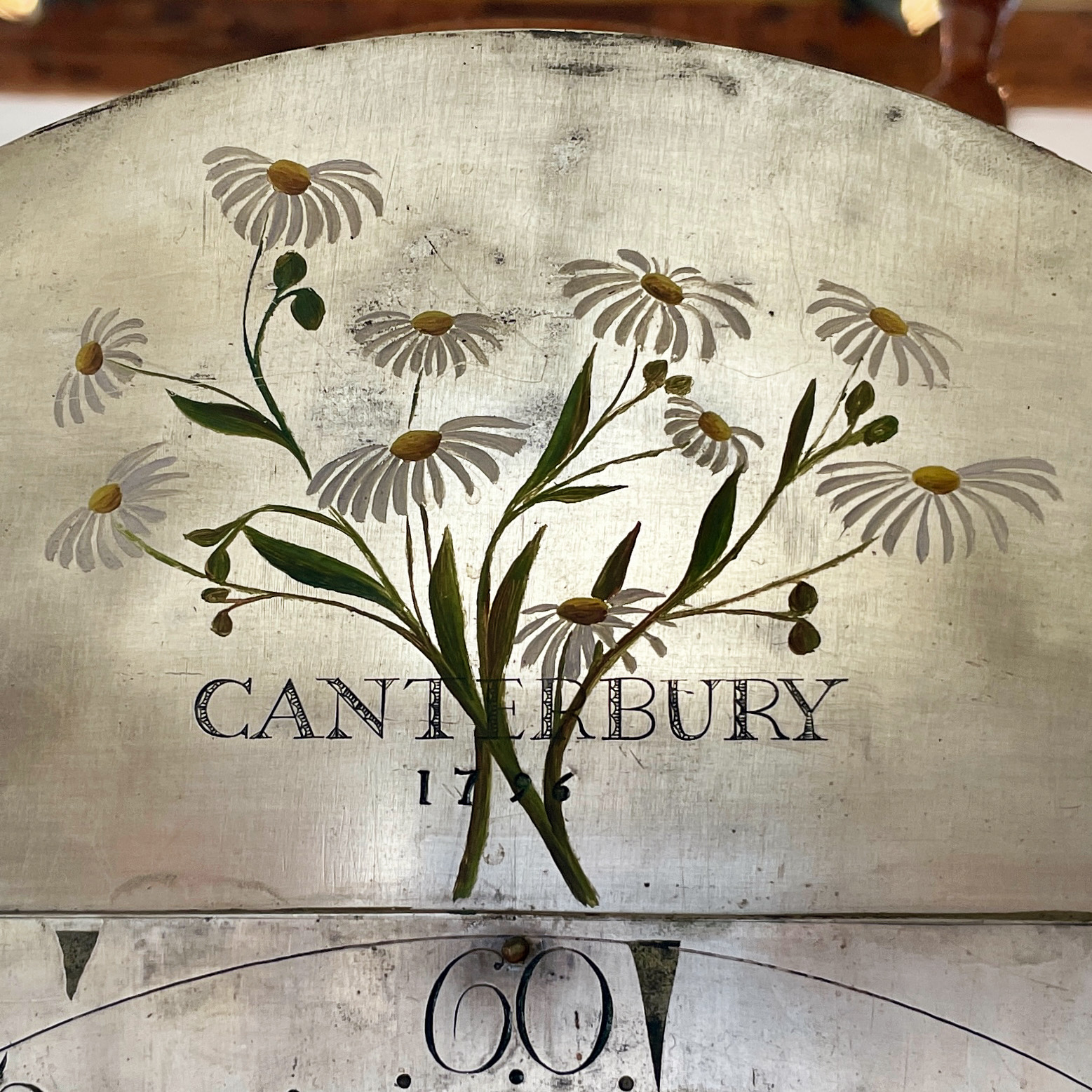Shaker Tall Case Clock
Canterbury, NH | 1796
Possibly Brother John Winkley (1767-1813) with botanical illustrations by Sister Cora Helena Sarle (1867-1956)
Birch, glass, brass, silvered brass, and paint
Original stain and varnish surface
83” h. x 23” w. x 11” d.
Illustrated: Jean M. Burks and Timothy D. Rieman, The Encyclopedia of Shaker Furniture (2003), p. 427.
Brother John Winkley was a member of the Canterbury Shaker community for a very short time—from 1792 to 1795. Even so, his legacy as a formative Shaker clockmaker persists, with exceptional examples of his work in numerous private and museum collections, such as the Henry Ford Museum (Dearborn, MI). Dated 1796, this Tall Case Clock was finished after Winkley apostatized and relocated to Durham, NH; however, given the similarity of this piece to other signed clocks, many have speculated that it was created by Winkley and dated subsequently.
The clockworks are fully functional and recently tuned by a master horologist. The eight-day, time-and-strike brass movement is driven by shaped lead weights and regulated by a pendulum.
The design of the birch and glass clock case exhibits the influence of an unadorned Chippendale style. The elongated waist and tombstone-shaped window evoke the cases of nearby Concord-based clockmakers Levi and Abel Hutchins and Timothy Chandler. The bonnet has a flat top with a large cornice molding, and the entire piece stands on a double-step molding base. Given the early date, the worldliness of this Tall Case Clock is not surprising—it was created in the formative decades of Shakerism before a unified design aesthetic was codified.
According to Eldress Josephine E. Wilson (1866-1946), this Tall Case Clock was first used by Elder Micajah Tucker (1764-1848), a fine Shaker cabinet maker known for his iconic Canterbury Dining Chair design. As one of the early New Hampshire Believers, Elder Micajah was appointed Deacon at the founding of the Canterbury community in 1792. He traveled as a missionary to the Midwest, spreading the Shaker gospel for over a decade before settling in Canterbury full-time in 1806.
Before he died, Elder Micajah gave the Clock to Elder Henry Clay Blinn (1824-1905), our favorite Shaker polymath. (In addition to serving as a spiritual leader, Elder Henry was a historian, woodworker, printmaker, writer, editor, dentist, healer, beekeeper, teacher, tinkerer, and tailor.) One of Elder Henry’s pupils, Sister Cora Helena Sarle (1867-1956), hand-painted the floral illustrations on the dial of this Tall Case Clock. In the mid-1880s, Elder Henry tasked Sister Helena with creating illustrations of native plants for a school textbook. She produced two journals containing over 180 drawings, later published as A Shaker Sister’s Drawings (1997). The asters illustrated in Notebook One, Plate 50, and Notebook Two, Plate 31, are virtually identical to the botanicals on the tombstone of this Clock.
The Clock remained in Elder Henry’s room until he died, at which point, it was moved to the upper hallway of the Canterbury Trustees’ Office. In 1944, Eldress Josephine sold the piece to photographer Stanton E. Becker. The sale to Becker was corroborated by Sister Ida Crook, who noted in her diary:
“July 7, 1944; Temp. 68° and 94°. Good hay day. … Mr. Becker’s furniture packed by Mr. Kinne and Mr. Davis. Mr. Kinne takes it to Concord. Charles Kinne takes it to West Roxbury. All but the Grandfather’s Clock belonging in upper hall at Office will go later… July 11, 1944; Temp 64°, rising to 84°… Dizzy takes clock to Mr. Becker.”
Overall, this piece is in a very fine state of preservation in its original stain and varnish surface. It is in excellent working order.
To inquire about this piece,
contact us by phone:
914-763-8144
Or, you can reach us by email: jkr@jkrantiques.com


